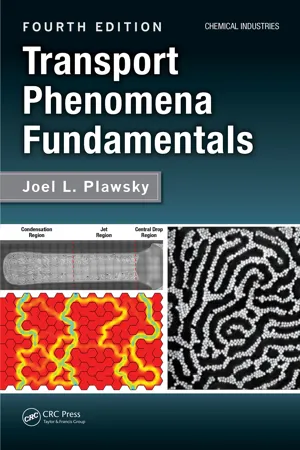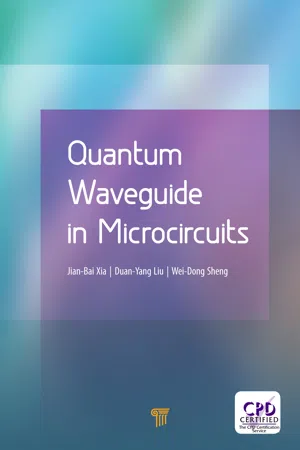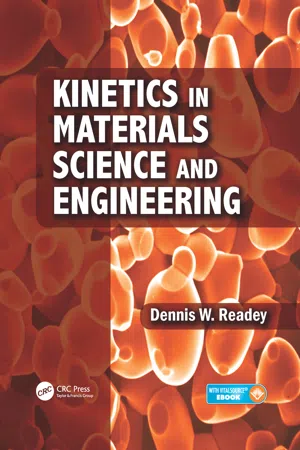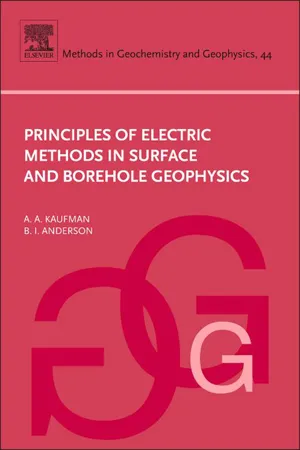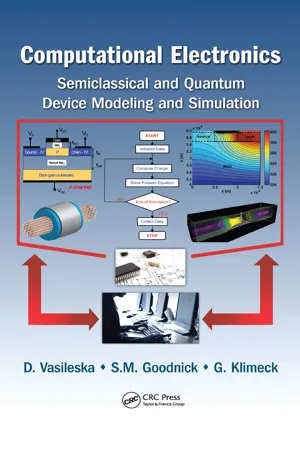Physics
Drift Velocity
Drift velocity refers to the average velocity of charge carriers, such as electrons, in a conductor when an electric field is applied. It is a key concept in understanding the flow of current in a circuit. Drift velocity is typically much slower than the speed of individual charge carriers due to collisions with atoms in the conductor.
Written by Perlego with AI-assistance
Related key terms
Related key terms
1 of 4
Related key terms
1 of 3
6 Key excerpts on "Drift Velocity"
- eBook - ePub
- Joel L. Plawsky(Author)
- 2020(Publication Date)
- CRC Press(Publisher)
a. Using Newton’s second law, that acceleration can be written as:a =e Em e(3.129) where me is the mass of an electron. At each collision with the stationary lattice atoms, the electron changes direction and begins to move again under the force exerted by the field. We define the Drift Velocity in terms of the field-induced acceleration and mean time between collisions,.λ f/v ¯v d= a=λ fv ¯eEλ fm ev ¯(3.130) The Drift Velocity determines the flux of charge carriers across any plane in the metal and hence determines the current density flowing through the metal. The current is defined by the same relationship we used in ionic transport.J =N Vev d(3.131) 𝒩 is the number of charge carriers and V the volume of metal. Combining equation (3.130) with equation (3.131) and realizing that the conductivity of the metal is just the current density divided by the electric field (Ohm’s Law, equation (3.132)),
gives a relationship between the conductivity, average electron velocity, and mean free path:σ =J E(3.132) σ =m ev ¯e 2λ fV N(3.133) The mobility is defined as the Drift Velocity per unit electric field, vd / E , and so we define a relationship between the mobility and electron velocity as we did for the conductivity and Drift Velocity.μ e=eλ fm ev ¯(3.134) So far, we have assumed that one species carries all the current. In many cases, such as semiconductors, both positive and negative charges are involved in transporting the current. The conductivity can then be expressed in terms of the mobilities of both charge carriers; similar to equation (3.119).σ =N +μ+e +N −μe −(3.135) The relationships we have just derived suffer from the same limitations as the kinetic theory expressions we derived for the diffusivity, thermal conductivity, and viscosity of gases. They do not consider any interaction between the electrons and the atoms with which they collide. As such, they work reasonably well for true metallic conductors such as silver or copper but break down seriously for semiconductor materials and metals with high resistivities. In these instances, we speak of an effective electron mass, meff , or effective hole mass, mheff , which is different for each material and serves to correct the mobilities in equation (3.135) . Table 3.14 - eBook - ePub
Developments in Surface Contamination and Cleaning, Vol. 1
Fundamentals and Applied Aspects
- Rajiv Kohli, Kashmiri L. Mittal(Authors)
- 2015(Publication Date)
- William Andrew(Publisher)
T , calculating the Drift Velocity for other pressures and temperature gradients is easily done in the free molecule regime limit.Figure 2.4 Thermophoretic deposition velocity. Dependence of the thermophoretic deposition velocity on particle diameter for six process pressures (argon at 293 K, k g /k p = 0.001, ∇T = 1 K/cm).2.5.3 Electric Drift Velocity
The Drift Velocity for a spherical particle moving under an applied electric field is given by:V E t=⋅ q ECK n3 π μd pAlthough the electrical force is independent of process conditions such as temperature and pressure, these quantities enter the expression for Drift Velocity through the drag-law contribution.(2.32)2.6 Eulerian Formulation
While the Lagrangian (particle tracking) method predicts particle transport by considering single particle motion, the Eulerian formulation predicts particle transport by viewing the particle concentration field as a continuum. In this case, the solution of the particle transport problem becomes very much like that posed by the flow field, i.e., there is one continuous equation for particle mass (concentration) conservation and one continuous equation for particle momentum (velocity) conservation for each particle size. Particle transport by diffusion (Brownian motion) is naturally included in this formulation. A great simplification is obtained if particle inertia is neglected, i.e., it is assumed that the particle instantaneously reaches the Drift Velocity where drag and imposed forces are in balance.g In this case, the particle momentum equation is no longer needed, and only the particle continuity equation for particle concentration n (particles/cm3 ) remains ([13] , p. 190; 20):+ U ⋅ ∇ n = ∇ ⋅ D ∇ n − ∇ ⋅∂ n∂ t+ ΛV p tn(2.33)where D (cm2 /s) is the Stokes–Einstein particle diffusion coefficient (discussed below) and Λ (#/cm3 /s) is a particle source/sink term to account for particle generation/consumption. The net Drift Velocity, V i t , appearing in Eq. (2.33) is the same one discussed previously. Although we will not make further use of the fact, it is interesting to note that Eq. (2.33) is applicable to either the Brownian motion of an individual particle or to the diffusion of a particle cloud taken from the continuum point of view ([13] , p. 191). For a single particle, n is interpreted as the probability of finding a particle at position (x , y - eBook - ePub
- Jian-Bai Xia, Duan-Yang Liu, Wei-Dong Sheng(Authors)
- 2017(Publication Date)
- Jenny Stanford Publishing(Publisher)
d can be obtained from the following equations:Figure 2.13 . Average velocity and average energy of electron in GaAs. The impurity concentration ND= 0 and T = 77K subjected to a time‐electric‐ field step as functions of time. (a) At t = 0 an electric‐field step ▵ E = 7kV /cm is applied; (b) an electric field pulse ▵ E = 70kV /cm with the duration ▵ t = 0.06 ps is applied.2.23d =∫v0T( t )d t , v( d )=d TFigure 2.13 shows the average velocity and average energy of electrons in GaAs. The impurity concentration ND= 0 and T = 77K are subjected to a time‐electric‐field step as functions of time [8 ]. The results are obtained by the Monte Carlo simulation. (a) At t = 0 an electric‐field step ▵ E = 7kV /cm is applied; (b) an electric field pulse ▵ E = 70kV /cm with the duration ▵ t = 0.06 ps is applied, shown by dashed curves in figures. The former case is called an overshoot, and the latter case is called ballistic by the authors.Figure 2.14 . Electron average velocities v as functions of traveling distance d :(a ) overshoot case and (b) ballistic case.When the electron energy is smaller than the polar optical phonon energy (case 1) or smaller than the intervalley energy of Γ and L valleys(case 2), the scattering probability is small. Thus, it is possible to obtain very high instantaneous drift velocities 3.5 × 107 and 108 cm /s , respectively in the two cases.△εΓ LThe distance and average velocity of electrons in the time period T can be calculated by Eq. 2.2 3. For the two cases the calculated v (d ) curves are shown in Fig. 2.14 . From the figure we see that in the case of an overshoot the maximum average velocity is only half of that in the ballistic case, which occurs at d = 375nm . At this distance the average energy reaches the polar optical phonon energy In the ballistic case, the average velocity decreases monotonously with the distance, and at d = 0 it has the maximum value 7.3 × 107 cm /s . This is because after the electric field pulse the electron does not have energy supplement and the farthest distance is about 200 nm - eBook - ePub
- Dennis W. Readey(Author)
- 2017(Publication Date)
- CRC Press(Publisher)
7 seconds is such a small number that the time prior to reaching Drift Velocity can certainly be neglected.13.5 ELECTRON MOBILITY
The relationship between mobility and relaxation time obtained in many texts on electronic materials is frequently not transparent: a rather “black box” approach is used or frequently the equation just appears. However, this result is easily obtained from Equation 13.8 , which can be written asv d=.F τm( 13.12 )For electrons moving in an electric field, E (V/m), the force is given by F = eE, where e = electron charge (1.602 × 10– 19 C). When discussing electronic conductivity in solids, the electron mobility (m2 /V s), is usually given by the symbol μe ,* and is related to the relaxation time for electrons to reach a given Drift Velocity in a given electric field or voltage drop. Of course, if the electrons did not reach a constant Drift Velocity, the current would continue to increase with time and that is not observed in reality. Electrons collide primarily with atomic vibrations and are scattered and this can be represented as a viscous drag force that leads to Equation 13.12 . Substitution of the electrical force acting on an electron into Equation 13.12 givesv d==F τm ee E τm ewhere me is the electron mass (9.11 × 10– 34 kg). Because the electron mobility is defined as the velocity per unit field , μe = vd /E orμ e=e τm e( 13.13 )which appears in most texts on electronic materials. Here, this result follows directly from the model leading to Equations 13.6 and 13.8 .For example, the electron mobility in doped silicon is on the order of 1000 cm2 /V s (Mayer and Lau 1990), which gives for the relaxation time:*a pretty short time!τ =eμ em eτ =(1000)c/m 2V s(9.11 ×)10k g− 31(1.602 ×)10C− 19()10 4c/m 2m 2τ = 5.7 ×10s− 1313.6 ABSOLUTE MOBILITY AND DIFFUSION
A combination of Equations. 13.1 and 13.7 gives - Alex Kaufman, B. Anderson(Authors)
- 2010(Publication Date)
- Elsevier Science(Publisher)
E is constant in this state, an ordered motion of the charges is observed. This ordered motion of charges is called electric current, or simply current. In metals, electric current is the motion of electrons, whereas in most rocks, it is the motion of ions dissolved in fluids filling the rocks' pores. Consequently, it is useful to distinguish between “electronic” and “ionic” conductivity. In both cases, however, a complex, random movement of microscopic charge accompanies an ordered motion in some direction, which is defined by the electric field. It is worth noting that the motion of each charge is determined by the magnitude and direction of the electric field in the vicinity of the point where the charge is located, and that, in this sense, its motion is independent of the field at other locations. The movement of charges in real materials is complicated by various factors, such as the complexity of a rock's pore space or the metal's crystal structures, the presence of fractures or defects, and the interaction between different charge carriers. To simplify the treatment, we imagine that in any elementary volume, all microscopic charges of each sign move with the same velocity. This assumption allows a simple transition from the micro- to macroscale and enables us to treat current as the motion of charge distributed continuously in a medium.2.1.2 Vector of Current Density
To describe the motion of charges, we introduce the vector of current density j (q ). Like any vector field, the current density has magnitude and direction, and can vary from point to point. Its direction gives the direction of charge movement at point q , while its magnitude is equal to the amount of charge passing in unit time through a surface of unit area centered at the point q and perpendicular to j- eBook - ePub
Computational Electronics
Semiclassical and Quantum Device Modeling and Simulation
- Dragica Vasileska, Stephen M. Goodnick, Gerhard Klimeck(Authors)
- 2017(Publication Date)
- CRC Press(Publisher)
e . The resultant expression for the current density then equals toJ ( 4.7 )( x )=cme 2τ mE( x )- e D.∂ c∂ xSubstituting e = −q for electrons and e = q for holes, we arrive at the drift-diffusion equations for electrons and holes ( 4.8 )J n( x )= q n( x )μ nE( x )+ qD ndn,d xJ p( x )= q p( x )μ pE( x )− qD p,d pd xwhere q is used to indicate the absolute value of the electronic charge. Although no direct assumptions on the nonequilibrium distribution function f (k , x ) were made in the derivation of Equation 4.8 , in effect, the assumption that the average velocity is basically given by the equilibrium thermal velocity means that the drift-diffusion equations are only strictly valid for very small perturbations of the equilibrium state (i.e., low fields). The validity of the drift-diffusion equations is empirically extended by introducing a field-dependent mobility μ(E ) and diffusion coefficient D (E
Index pages curate the most relevant extracts from our library of academic textbooks. They’ve been created using an in-house natural language model (NLM), each adding context and meaning to key research topics.
Explore more topic indexes
Explore more topic indexes
1 of 6
Explore more topic indexes
1 of 4
